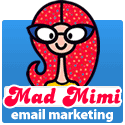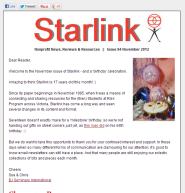 In ‘tidying up’ our database of Starlink newsletter subscribers, I’ve been inspired to reflect on what we’ve learned about writing newsletters that remain appealing to and useful for our readers.
In ‘tidying up’ our database of Starlink newsletter subscribers, I’ve been inspired to reflect on what we’ve learned about writing newsletters that remain appealing to and useful for our readers.
Our learning has been part of a long and fascinating journey, since Starlink first began as a paper-based publication 17 years ago! It’s seen a number of changes over that time, both in its readership and content.
But one thing that has remained constant, much to our delight, is its popularity with our readers.
Our Melbourne Age newspaper had an article last July, entitled Dumped: 10 Reasons Customers Unsubscribe from Your Newsletter. The article pointed out that
“91 per cent of users change their mind about newsletter subscriptions after committing“.
But, with Starlink, apart from bounces when people presumably forget to let us know when they leave their jobs or their email addresses have changed, our ‘unsubscribe’ list is a small one.
Although some folk do unsubscribe when they change jobs or retire and the newsletter is no longer relevant for them, we do not find subscribers change their minds shortly after signing up.
And checking the stats, only 12 people have unsubscribed in the last two years! So we must be getting something right. :)
With so many different forms of communication clamouring for our attention these days, it’s also good to know email newsletters can still have a place.
So what has worked for us? Here are 12 useful tips we’ve learned along the way.
1. Content is King
Providing great content is the first and foremost priority. Your readers need to know every issue will be relevant, interesting, amusing, useful, and/or inspiring.
With Starlink, our challenge is that our readership covers a very broad spectrum – particularly across the nonprofit sectors. But we try to incorporate at least one item each month that will appeal to one or more of each of these sectors.
Indeed, far more time is spent sourcing and selecting content we think will be helpful or interesting for our readers – and ensuring we get a divers ‘mix’ of items – than is spent putting the actual newsletter together each month! :)
2. Design: “Keep it Simple, Sweetheart”
It’s important readers can access information in each newsletter easily. The overall design needs to be clean, clear and not too ‘busy’. Using headings, sub-headings, short paragraphs, bullet points and adequate white space helps to enhance readability – particularly for on-screen reading.
This is perhaps especially important for an html newsletter, but also applies to text-based newsletters. Whether opening your newsletter on their desktop computer or (as is increasingly true) reading it on the small screen of a mobile phone, your readers will appreciate it if your newsletter is clear, concise and easy to read.
3. Less is More
Keep long articles (more than 300 words or so) for your website or blog. If you want to include them in your newsletter, write a ‘teaser’ or short summary and provide a link to the longer article online.
Keep newsletter items brief so they’re useful for busy people and your newsletter can be quickly scanned for items of particular interest – similar to the way in which people approach newspaper headlines or web search results.
4. Personalise
Addressing individual subscribers by name at the start of each newsletter is another good tip, helping you build a better connection/relationship with your readers. Automated email delivery services (see below) will make this easy.
5. Proof Read
 Check, check and recheck before sending. Spelling or grammatical mistakes, links that don’t work – these things will frustrate readers and make you appear less professional. But, provided you always do check things carefully, don’t beat yourself up if a mistake does slip through.
Check, check and recheck before sending. Spelling or grammatical mistakes, links that don’t work – these things will frustrate readers and make you appear less professional. But, provided you always do check things carefully, don’t beat yourself up if a mistake does slip through.
None of us is perfect – so mistakes will happen. Let your readers know – immediately if it’s a link problem, or in the next issue if it’s a relatively minor error for which you want to apologise. Be human and your readers will appreciate it. :)
6. Enable Reading Online
For an electronic newsletter, always provide a link where it can be read online. Either host the issue on your own website, or provide the link for it where it’s hosted with your mailing service provider. (See next tip)
7. Use a Mail Service Provider
 Ok, so it’s possible to keep a subscriber list manually and produce each newsletter using a text editor and html markup code. In fact, this is what we did with Starlink for some time after it moved from its paper-based origins to its electronic form. But oh boy, what a time-consuming process it was! :)
Ok, so it’s possible to keep a subscriber list manually and produce each newsletter using a text editor and html markup code. In fact, this is what we did with Starlink for some time after it moved from its paper-based origins to its electronic form. But oh boy, what a time-consuming process it was! :)
It’s far more efficient and effective to use one of the many mail/newsletter providers available now. Our own choice is Mad Mimi – it’s very user-friendly, easy to set up and they have great customer service. But there are many other popular choices, such as Mail Chimp, Constant Contact. Aweber and the like.
You can read more in our earlier blog post, Staying Sane with Mad Mimi, in which there are also links to downloadable files about the research we did into mail service providers at that time. As our research was done a year ago, some of the data may now be out of date in relation to the service/program costs or features offered. But it’s mentioned here as it may nevertheless be a useful starting point for others.
8. Welcome Message for New Subscribers
When someone subscribes to your newsletter, make sure they receive a clear and friendly welcome message as a new subscriber. Whether you send one manually, or set it up as an automated response, it’s important that new readers feel welcomed and invited to stay.
9. Privacy is Paramount!
 Never, never, ever share your subscribers’ email addresses with anyone else without seeking permission first! Not only is this against privacy and spam laws, but it is disrespectful.
Never, never, ever share your subscribers’ email addresses with anyone else without seeking permission first! Not only is this against privacy and spam laws, but it is disrespectful.
If we discover there may be a helpful connection to make between one of our subscribers and another – or with a particular service provider of some kind – we always contact them personally first to ask permission before making an introduction.
10. Quality Not Quantity
This applies not only to the content of your newsletter, but also to your subscriber database. It is far better to have fewer subscribers who are active readers and supporters than to have a list of thousands who rarely, if ever, actually open the newsletter, read it and click on the links you’ve shared.
The quality of your mailing list does not lie in how many subscribers you have, but in how many open the newsletter, how many are active, how many bounce, and what your overall unsubscribe rate may be.
Never fret over unsubscribe emails – unless they are arriving in great numbers which is a clear sign you need to review and revise what you’re sending out!
11. Measure Opens & Click Throughs
 Related to the above tip, this is another thing we’ve found very helpful in monitoring our list of subscribers and how our newsletter is rating with them.
Related to the above tip, this is another thing we’ve found very helpful in monitoring our list of subscribers and how our newsletter is rating with them.
For this, you’d need to use either a mailing service provider that offers such tracking services or have visitors to your online newsletter tracked through something such as Google Analytics. If your newsletter is going out to thousands, but is only opened by a handful of your readers, it’s not doing what it’s supposed to do.
One other thing about opens and click throughs – do not assume the statistics immediately available are the most relevant. Statistics may be available within 24-48 hours of sending our your newsletter, but we’ve found they are not usually the most accurate measure.
Many of our readers will open our newsletter several days later – indeed, perhaps up to a couple of weeks later stats are still adding up. We’ve even had feedback from some readers who say the ‘save’ Starlink to read when they’ve got time to enjoy it properly. :)
12. Subscribe and Unsubscribe Forms/Links
You must ensure every issue of your newsletter contains an unsubscribe link – this helps it to comply with anti-spam regulations. However it’s also useful to include a subscribe link – some of your readers may forward the newsletter to friends or colleagues, so this link makes it easy for others to join your mailing list.
Placing subscribe and unsubscribe forms prominently on your website is also an important aspect of attracting new readers and enabling people to unsubscribe easily – which will help to keep you off the anti-spam lists. :)
If you can also create a form where existing subscribers can update their contact details and/or email address, this is also helpful for your readers as well as for you.

 Our monthly newsletter
Our monthly newsletter
Speak Your Mind